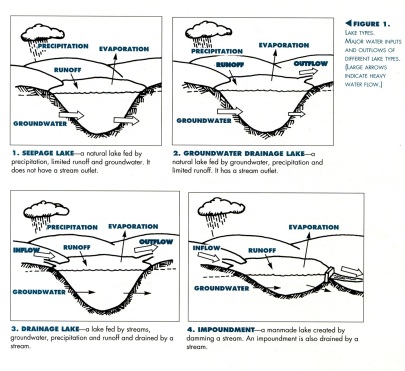The ups and downs of Michigan inland lake levels
Different types of inland lakes may vary in response to the 2012 summer drought.
 Lakefront property owners, and others who enjoy Michigan’s 11,000 inland lakes, may be experiencing low water levels on their favorite lake this summer. Those who spend time on multiple lakes may notice that some lakes have been affected more than others by the drought.
Lakefront property owners, and others who enjoy Michigan’s 11,000 inland lakes, may be experiencing low water levels on their favorite lake this summer. Those who spend time on multiple lakes may notice that some lakes have been affected more than others by the drought.
Lakes of all types experience some degree of water level fluctuation in response to precipitation cycles. Surface evaporation is a key factor during hot summer months, but the potential range of fluctuation on a particular lake involves additional factors including lake type, water sources, and how lake levels are manipulated.
Lakes may be natural or man-made, and can be categorized into four different types (seepage lake, groundwater drainage lake, drainage lake or impoundment) as depicted in Figure 1. The relative contribution of groundwater and surface water sources influence the lake’s response to precipitation events and cycles. Groundwater is the dominant source of water in seepage lakes (1) and in groundwater drainage lakes (2). Surface water is the dominant source of water in drainage lakes (3) and in impoundments (4).
The term “natural” lake refers to a lake that did not originate by the damming (or impoundment) of a stream or river. Many lakefront property owners expect water levels in natural lakes to remain constant. However, natural lakes experience fluctuations and the degree to which they respond to local and regional precipitation events generally is related to the amount of surface water runoff the lake receives from its watershed.
For example, a drainage lake that receives the majority of its water from a stream or river would be expected to respond more rapidly to precipitation events than a seepage lake in which the primary water source is groundwater (springs). Drought conditions, resulting in reduced stream flows, usually affect drainage lake levels more quickly than seepage or groundwater drainage lakes.
Many natural lakes (and even large wetlands) have been equipped with legally established level control structures for the purpose of seasonally manipulating water levels. For example, a level control structure may be operated to maintain a higher water level in the summer to accommodate recreational boating and a lower level in the winter to reduce ice damage to shoreline properties. During drought conditions, wetlands and waterways downstream of a level control structure may be affected by the inability of water to naturally flow through the system.
Climate change models for the Great Lakes region predict longer periods of high temperatures, shorter periods of ice cover, increased evaporation and lower water levels. However, more extreme precipitation events may result in localized flooding – particularly in drainage lakes.
For more information on Michigan’s water resources and inland lakes, please refer to “An Introduction to Michigan’s Water Resources.”



 Print
Print Email
Email




